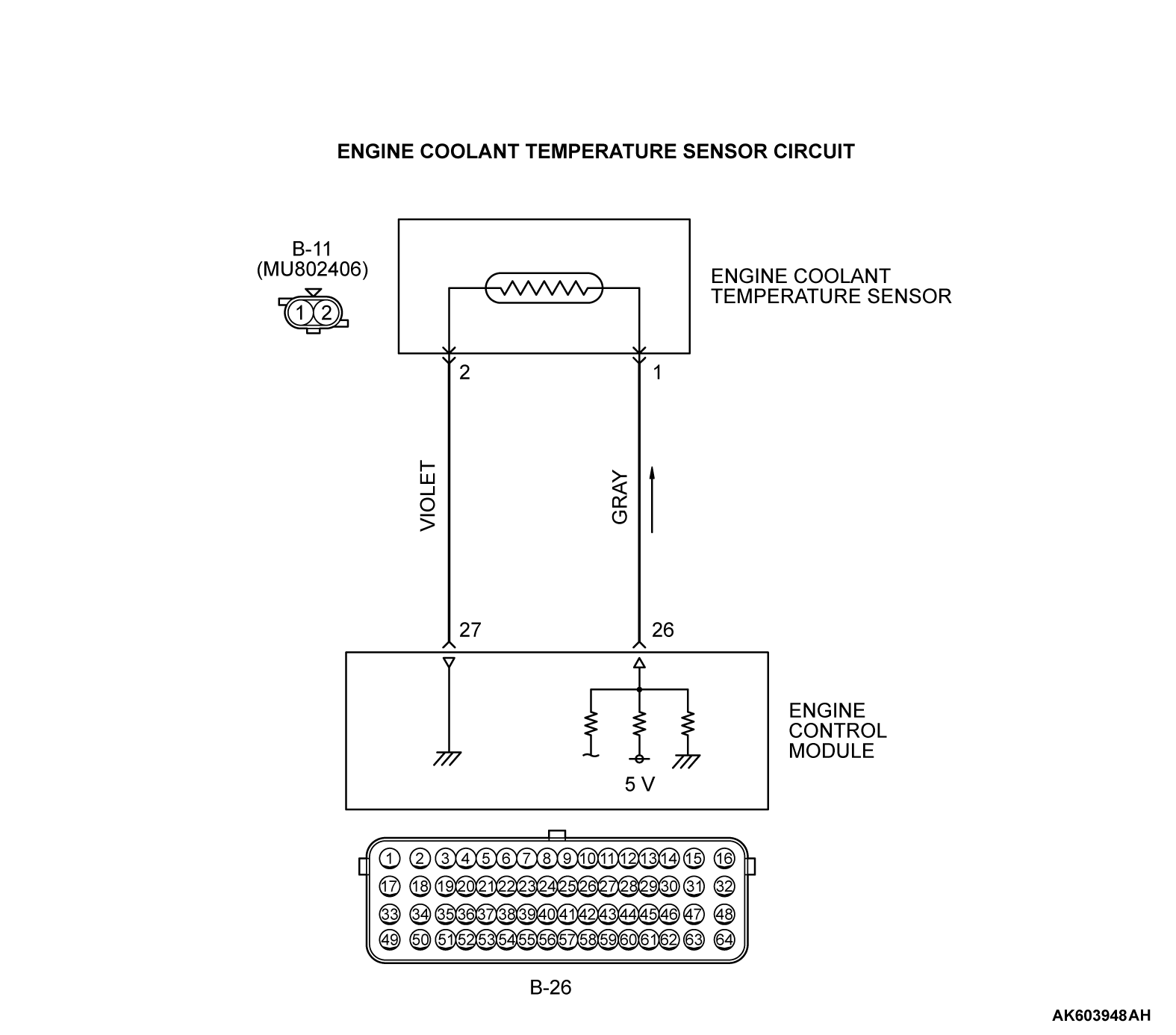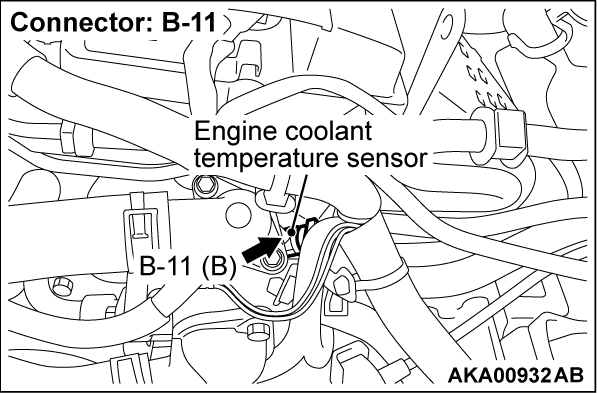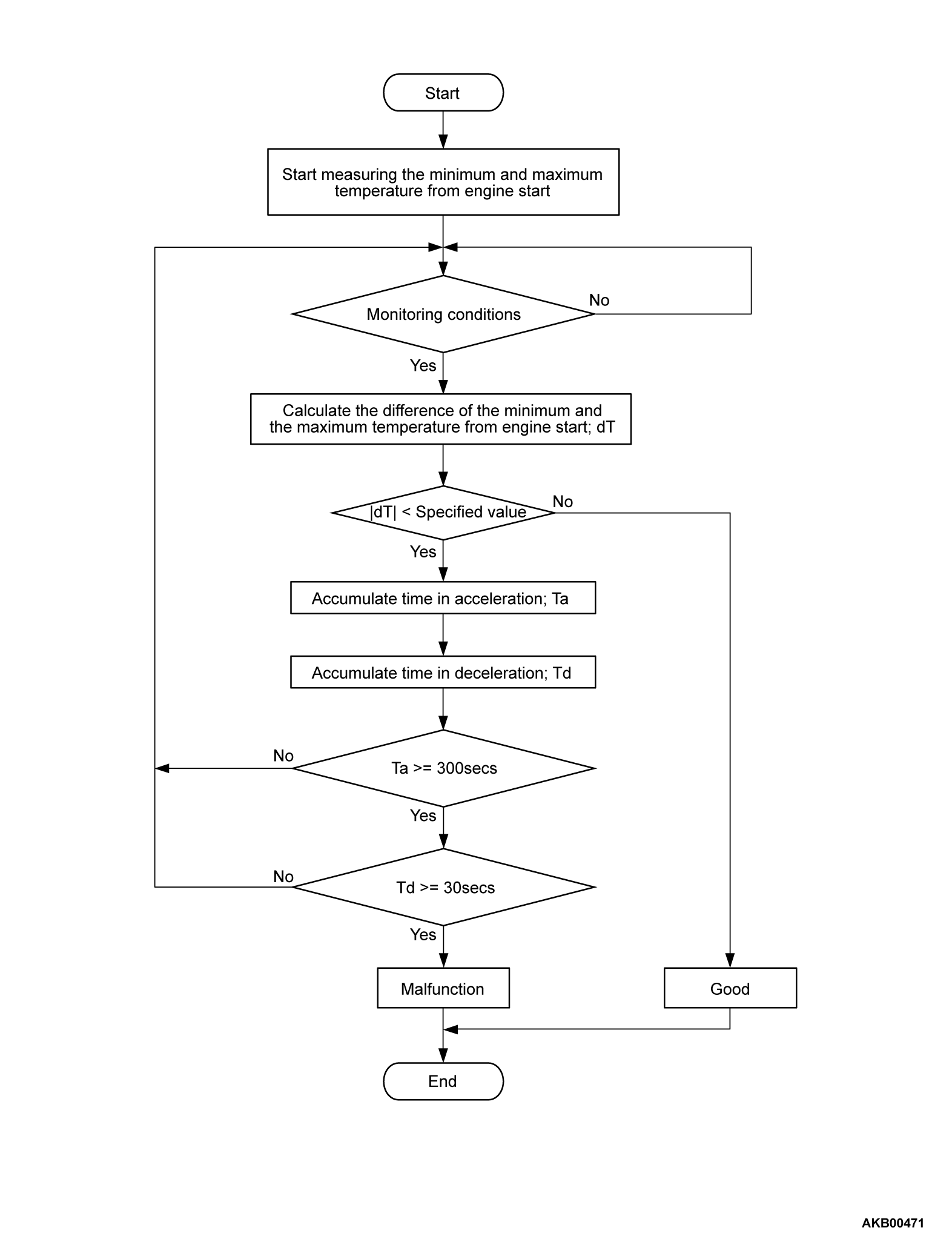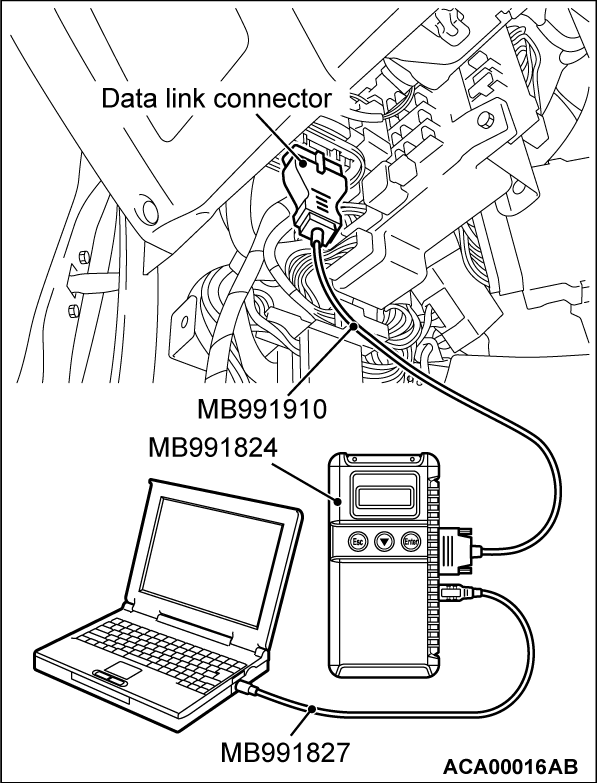DTC P0116: Engine Coolant Temperature Circuit Range/Performance Problem
CIRCUIT OPERATION
- 5-volt voltage is applied to the engine coolant temperature sensor output terminal (terminal No. 1) from the ECM (terminal No. 26) via the resistor in the ECM. The ground terminal (terminal No. 2) is grounded with ECM (terminal No. 27).
- The engine coolant temperature sensor is a negative temperature coefficient type of resistor. It has the characteristic that when the engine coolant temperature rises the resistance decreases.
- The engine coolant temperature sensor output voltage increases when the resistance increases and decreases when the resistance decreases.
TECHNICAL DESCRIPTION
- The engine coolant temperature sensor converts the engine coolant temperature to a voltage and outputs it.
- The ECM checks whether this voltage is within a specified range.
DESCRIPTIONS OF MONITOR METHODS
- Engine coolant temperature sensor output voltage does not change for specified period when engine coolant temperature sensor output voltage at engine start is over 7°C (45°F).
MONITOR EXECUTION
- Once per driving cycle
MONITOR EXECUTION CONDITIONS (Other monitor and Sensor)
Other Monitor (There is no temporary DTC stored in memory for the item monitored below)
- Not applicable
Sensor (The sensor below is determined to be normal)
- Mass airflow sensor
- Intake air temperature sensor
Check Conditions
- Engine coolant temperature was more than 60°C (140°F) when the engine started.
- The accumulation is more than 300 seconds during the acceleration having the mass airflow rate of 12 g/sec or more.
- The accumulation is more than 30 seconds during the deceleration having the mass airflow rate of 9 g/sec or less.
Judgment Criteria
- Engine coolant temperature fluctuates within 1°C (1.8°F) after 330 seconds have passed since the engine was started.
- However, time is not counted if any of the following conditions are met.
- Intake air temperature is less than -10°C (14°F) and is more than 60°C (140°F).
- During fuel shut-off operation.
Check Conditions
- Engine coolant temperature is between 0°C (32°F) and 60°C (140°F) when the engine started.
- The accumulation is more than 300 seconds during the acceleration having the mass airflow rate of 12 g/sec or more.
- The accumulation is more than 30 seconds during the deceleration having the mass airflow rate of 9 g/sec or less.
Judgment Criteria
- Engine coolant temperature fluctuates within 3°C (5.4°F) after 330 seconds have passed since the engine was started.
- However, time is not counted if any of the following conditions are met.
- Intake air temperature is less than -10°C (14°F) and is more than 60°C (140°F).
- During fuel shut-off operation.
FAIL-SAFE AND BACKUP FUNCTION
- Control as if the engine coolant temperature is 80°C (176°F).
TROUBLESHOOTING HINTS (The most likely causes for this code to be set are:)
- Engine coolant temperature sensor failed.
- Harness damage or connector damage.
- ECM failed.
DIAGNOSIS
Required Special Tool:
- MB991958: Scan Tool (M.U.T.-III Sub Assembly)
- MB991824: V.C.I.
- MB991827: USB Cable
- MB991910: Main Harness A
STEP 1. Using scan tool MB991958, check data list item 6: Engine Coolant Temperature Sensor.
| caution | To prevent damage to scan tool MB991958, always turn the ignition switch to the "LOCK" (OFF) position before connecting or disconnecting scan tool MB991958. |
(1) Connect scan tool MB991958 to the data link connector.
(2) Turn the ignition switch to the "ON" position.
(3) Set scan tool MB991958 to the data reading mode for item 6, Engine Coolant Temperature Sensor.
- The engine coolant temperature and temperature shown with the scan tool should approximately match.
(4) Turn the ignition switch to the "LOCK" (OFF) position.
Is the sensor operating properly?
STEP 2. Check harness connector B-11 at engine coolant temperature sensor for damage.
Is the harness connector in good condition?
STEP 3. Check the engine coolant temperature sensor.
STEP 4. Check the continuity at engine coolant temperature sensor harness side connector B-11.
(1) Disconnect the connector B-11 and measure at the harness side.
(2) Check for the continuity between terminal No. 2 and ground.
- Continuity (2 ohms or less)
Does continuity exist?
STEP 5. Check harness connector B-26 at ECM for damage.
Is the harness connector in good condition?
STEP 6. Check for harness damage between engine coolant temperature sensor connector B-11 (terminal No. 2) and ECM connector B-26 (terminal No. 27).
STEP 7. Check harness connector B-26 at ECM for damage.
Is the harness connector in good condition?
STEP 8. Check for harness damage between engine coolant temperature sensor connector B-11 (terminal No. 1) and ECM connector B-26 (terminal No. 26).
STEP 9. Using scan tool MB991958, check data list item 6: Engine Coolant Temperature Sensor.
(1) Turn the ignition switch to the "ON" position.
(2) Set scan tool MB991958 to the data reading mode for item 6, Engine Coolant Temperature Sensor.
- The engine coolant temperature and temperature shown with the scan tool should approximately match.
(3) Turn the ignition switch to the "LOCK" (OFF) position.
Is the sensor operating properly?
![[Previous]](../../../buttons/fprev.png)
![[Next]](../../../buttons/fnext.png)








